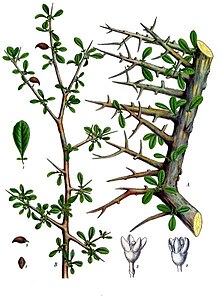Commiphora myrrha
Appearance
| Commiphora myrrha | |
|---|---|

| |
| Commiphora myrrha | |
| Scientific classification | |
| Kingdom: | |
| (unranked): | |
| (unranked): | |
| (unranked): | |
| Order: | |
| Family: | |
| Genus: | |
| Species: | C. myrrha
|
| Binomial name | |
| Commiphora myrrha (Nees) Engl.[1]
| |
| Synonyms[2] | |
|
List
| |

Commiphora myrrha, called myrrh,[1] African myrrh,[1] herabol myrrh,[1] Somali myrrhor,[1] common myrrh,[3] or gum myrrh[citation needed] is a tree in the Burseraceae family. It is one of the primary trees used in the production of myrrh, a resin made from dried tree sap. The tree is native to the Arabian peninsula (Oman, Yemen) and to Africa (Djibouti, Ethiopia, Somalia, Northeast Kenya).[4]
Growth
Commiphora myrrha is very spiny and it grows to a height of about 4 m (13 ft). It grows at an altitude of between about 250 to 1,300 m (820 to 4,270 ft) with a yearly mean rainfall of about 23 to 30 cm (9.1 to 11.8 in). It does best in thin soil, primarily in areas with limestone.[5]
References
- ^ a b c d e "Commiphora myrrha information from NPGS/GRIN". www.ars-grin.gov. Retrieved 2009-01-15.
- ^ "The Plant List: A Working List of All Plant Species". Retrieved June 6, 2014.
- ^ Sandra Kynes (8 November 2013). Mixing Essential Oils for Magic: Aromatic Alchemy for Personal Blends. Llewellyn Worldwide. pp. 191–. ISBN 978-0-7387-3715-7.
- ^ "Commiphora myrrha". www.cactus-art.biz. Retrieved 2009-01-15.
- ^
"Species Information". www.worldagroforestrycentre.org. Archived from the original on 2011-09-30. Retrieved 2009-01-15.
{{cite web}}: Unknown parameter|deadurl=ignored (|url-status=suggested) (help)
External links
